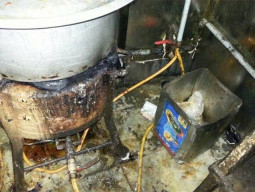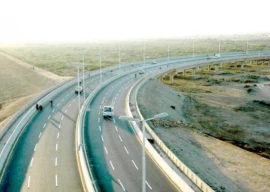
The villages on this strip of land are under constant threat from the sea - storms, cyclones and when Cyclone Phet hit the area, more than 5,000 families had to move as over 500 huts were uprooted.
Back in Hajamro, one of the four major creeks of the Keti Bunder coast, the sea is choppy but currently in low tide. It leaves spume across the edge of the Siddique Dablo village, a reminder of the limited time the villagers have.

A few metres from the last of the spume lines is a thatched hut which is the residence of Abdur Rahman. He points at the edge of the raised mud platform atop which his hut sits. "This is where the water rises to during high tide," he said. "When the tide is high, it can come up to our ankles while we are inside the house."
But the rising water is not his immediate concern. Rahman worries about having clean drinking water. "Getting drinking water is a big problem here," he said. "We have to get it from Keti Bunder city."
Sea intrusion, owing to decreasing downflow of fresh water from River Indus in this delta has rendered these areas bereft of fresh water. "A small can of eight gallons of water will cost us Rs20," said Abdur Rahman. "A larger drum which can store 40 gallons of water costs around Rs100."
On average, each household in the Siddique Dablo village spends between Rs3,000 to Rs4,000 per month on water.
The mangroves
Despite replantations by the government and non-governmental organisations, the fight to rebuild the mangrove banks has been difficult. World Wildlife Fund and its Capacity on Climate Change Adaptation in Coastal Areas of Pakistan (CCAP) Site Coordinator Tahir Abbasi explains that they have had success with only a third of the mangroves that they planted. "The good thing about the Avicennia marina is that when it matures, it releases the seed which falls on the ground," he said. "When the tide comes in, the water takes the seed and spreads it."
Room with a view
Sulaiman lives in a house with three rooms. It is the closest to the edge of the water, he claims that the mangroves near his house were planted. But those across the small village had grown naturally.
Mangroves are vital for coastal regions to keep the sea out and help create a pool of freshwater. The freshwater also brings in fish which lay eggs. This creates a stable source of income for the area residents. According to Abbasi, the mangroves are the last line of defence for coastal settlements. "We have built them and raised wooden platforms so that the water does not come into the houses even during high tide."
In Siddique Dablo, however, the WWF have built a model house and around 20 raised platforms for the 30 odd houses, only a handful are being built upon.
Abdur Rahman, a villager, said that the arrangement with the WWF was that the NGO would build the platforms and the villagers would then build their houses on top of it using their own resources. He added that it costs them around Rs12,000 to build a house on the platform.
Sulaiman and another villager, Khalid, who lives a little upstream in the village, agree. "The platforms are solid because its legs are three-foot above ground and are equally sunk beneath the ground," they said. "But the houses on top are not strong enough to withstand high winds." According to Rahman, the last time there was a storm the police came and took them to Ibrahim Hyderi in trucks. "After the storm," he said, "they brought us back in cars but there was nothing left here."
Call me maybe
The WWF’s CCAP programme has provided the villagers with at least one benefit. By installing solar panels in the area, the villagers have the facility of charging their cell phones without having to pay Rs10 in Keti Bunder for it.”Now we can keep in contact with others who are out at sea fishing,” said Khalid.
Published in The Express Tribune, May 31st, 2014.
1732603002-0/lamar-(4)1732603002-0-405x300.webp)
1720420084-0/brad-pitt-(2)1720420084-0-165x106.webp)















COMMENTS
Comments are moderated and generally will be posted if they are on-topic and not abusive.
For more information, please see our Comments FAQ